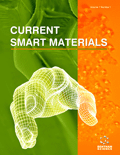Abstract
Background: The ternary Ni-Mn-Sn alloys are an important series of energy-materials of magnetocalory used as ‘small magnets and tools' of magnetic cooler, spin-polarizer, sensor, and other devices. The basic aim of this article is to explore a small Cr → Mn doping in tailoring functional properties in a series Ni50Mn37-δCrδSn13 (δ ≤ 2.0) of alloys of engineered shapes of cylindrical discs (10-20 mm diameters and 5-10 mm widths), thin sheets, or laminates.
Methods: A common vacuum arc melting process is used to produce the master alloys of cylindrical discs. Laminates of a few mm of thickness are machined from the discs that are quite machineable. No post-thermal annealing is required to tune the properties any more.
Results: The Ni50Mn37-δCrδSn13 (δ ≤ 2.0) alloys contain thin microscopic strips (12-45 nm thickness) of single magnetic domains of tailored magneto-mechanical properties in the spins pin-down at the boundaries. Chromium finely tunes morphology in the alloy growing in small crystallites in preferred {202} facets, with the crystal density decreased regularly, 7.614 g/cm3 at δ → 2.0 against an initial value 7.871 g/cm3, in an orthorhombic structure. The aspect ratio a/c = 0.8569 (b/c = 0.9293) is reduced successively over the parent value 0.9526 (b/c = 0.9848) in a promoted orthogonality. Any local microstrain (τ) in builds-up reinforces the microscopic strips reorder in a ‘second level hierarchical structure' in a way it controls its average value. The Young's modulus and Vickers hardness peak-up to be 115.8 GPa and 6.3 GPa respectively in a maxima induced in a critical τ ~ 2.7% (δ → 1.4), subject to a typical 981 mN upload.
Conclusion: The results describe a hybrid nanostructure Ni50Mn37-δCrδSn13 (δ ≤ 2.0) forms on adaptive interfaces and twined boundaries and it is what it harvests a strain-induced mechanical toughness. Any residual amorphous phase in persists triggers the mechanical, magnetic and other properties in coreshell crystallites on self-adjustable coherent interspaces and interfaces in a hierarchical nanostructure.
Keywords: Heusler alloys, smart structures, magnetocaloric materials, chromium doping, phase transformation, layered structures, hierarchical nanostructures.
Graphical Abstract
 23
23




